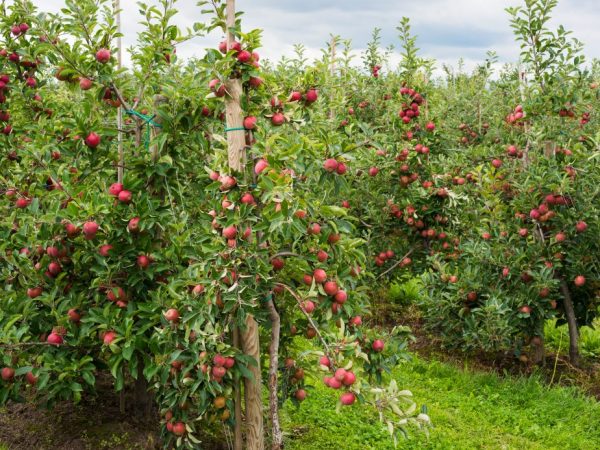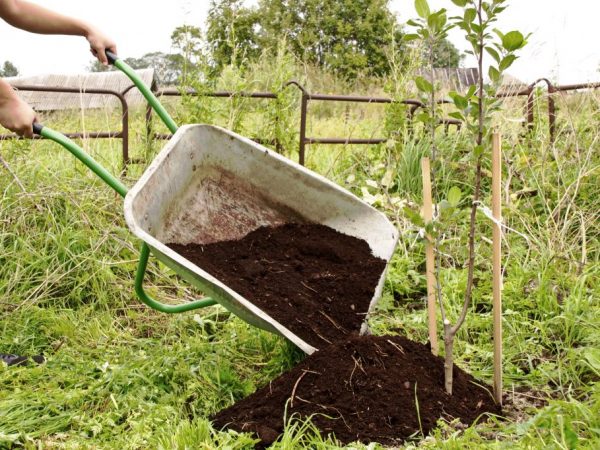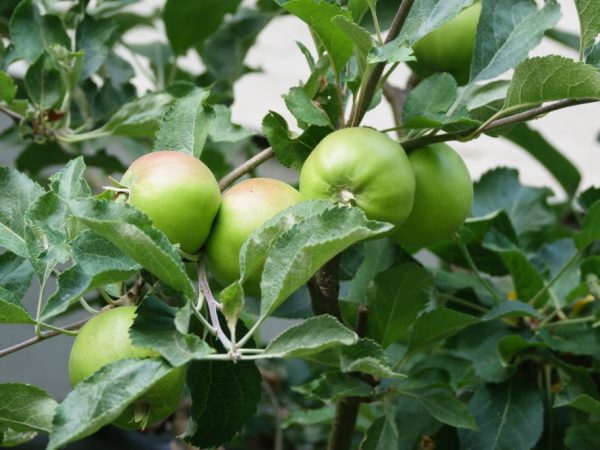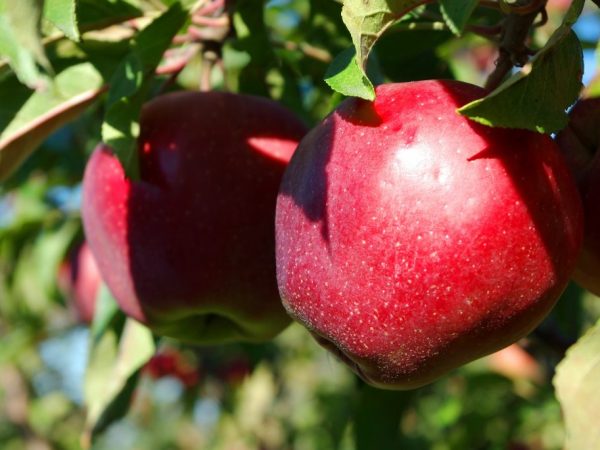Features of growing the Spartan apple tree
One of the best achievements of Canadian breeding is the Spartan apple tree. This crop, bred in 1926, has the unique qualities of its ancestors (Macintosh and Pepin Newtown) - high productivity and good resistance against diseases. Today this variety is successfully used in private gardening.
- Varietal features
- Advantages and disadvantages
- Conditions for successful cultivation
- Preparing the soil and pits
- Landing technique
- Care rules
- Watering
- Top dressing
- Crown formation
- Preparing for winter
- Pests and diseases
- Ripening and fruiting
- Collection and storage
- Rootstocks
- Growing in different regions
- Gardeners' opinion

Features of growing the Spartan apple tree
Varietal features
A very important feature of this variety is self-fertility, so that when planting, the presence of other plants in the neighborhood is not required.
At the same time, the apple tree is itself an excellent pollinator for other varieties that bloom in early or mid-May.
The description of the tree includes several distinctive qualities:
- a plant of short stature with a spherical crown (average height 4-4.5 m);
- usually the central conductor develops at a slight slope;
- branches are erect, covered with smooth dark brown or burgundy bark;
- the crown is capable of intensively increasing young growth, therefore it needs regular annual pruning;
- leaves are round, small in size, smooth, with a glossy surface;
- fruit ovaries are formed mainly on the ringlets;
Spartan apples have a thick skin, they have a round, slightly tapering shape. Average weight 150 g.
The surface is slightly ribbed, burgundy in color with a waxy bloom, which gives the fruit a purple tint.
Tasting taste score - 4.8 on a 5-point scale.
The taste is harmonious - sweetish-sour, the flesh is firm, with a dense structure, creamy or white.
Advantages and disadvantages
The Spartan apple variety includes several important positive characteristics:
- high yields (a young apple tree gives about 25 kg of a crop, an adult one - up to 80 kg of fruits);
- excellent taste, marketability;
- good transportable properties;
- long shelf life - until March-April in the basement or cellar, until May in the refrigerator;
- fruits contain a large amount of useful and nutritious substances;
- high resistance to scab and powdery mildew;
- early fruiting - the tree gives its first fruits three years after planting.
This culture has some disadvantages:
- the Spartan apple tree is very sensitive to spring frosts and severe winters, therefore, when planting in the Mid-latitudes and in the North, it needs good shelter;
- the second drawback is that with age, in the absence of a rejuvenating haircut, the fruits on the tree become smaller.
Conditions for successful cultivation
For planting seedlings, you should choose a site well-lit by the sun, because in a shaded place, they will develop slowly and bear poor fruit.
Loamy soil is suitable for cultivation. You can improve the composition of clay soil by adding sand, compost and peat to the site at the rate of a bucket of each component per 1 m².
Choose an area with deep groundwater flow (at least 2 m). Better to plant the apple tree on a hill where there are no winds.
Young trees can be planted both in spring and autumn. For middle latitudes, spring disembarkation will be preferable - in the last decade of April. In the south, they are planted in the fall (late September or early October) or in the spring at the end of April.
Preparing the soil and pits

A young seedling needs support
Fertilization and pit preparation are carried out two weeks before planting. First, the remains of last year's vegetation are removed on the site, then they are dug up, the surface is leveled.
In a group landing, holes are dug at a distance of 4 m from each other with the same distance in a row. The depth and diameter of the pits should correspond to the size of the plant root system - approximately 70x80 cm.
To create good drainage, the bottom of the pit is covered with cut tree branches, stones or rubble.
Then the hole is half filled with fertile soil:
- superphosphate - 200 g;
- potassium sulfate - 100;
- ash - 100 g;
- berry Giant - 2 packages;
- humus - 3 buckets.
All these components are mixed with earth and poured into the pit. From above, to prevent the risk of burning the roots, sprinkle the fertile soil with ordinary garden soil. A peg is driven in next to the formed hill, which will serve as a support for the seedling.
Landing technique
Before planting, on each seedling, the roots are cut 3-4 cm in length, then dipped into a clay solution (4 kg of clay for 3 liters of water).
After an hour of soaking, the seedlings are removed, slightly dried and lowered into the pit. When planting, roots must be leveled to ensure proper growth and development. After that, the tree is sprinkled with the remaining mixture of fertile soil and trampled.
To avoid rotting of the center conductor, it is important that the root collar is above the ground.
After planting, 2-3 holes are made for watering at a distance of 30 cm from the trunk. The tree is watered with settled water. Consumption per young plant - 15 liters. The seedling is tied up with twine or rope to a peg. After all the moisture has been absorbed, the near-trunk zone is mulched with garden soil.
To stimulate the growth of the lateral branches, immediately after planting, the central conductor is cut 20 cm from the top.
Care rules
In order for a tree to grow healthy, fully develop and bear fruit abundantly, it needs to be given proper care.
Watering
Water several times throughout the season. The number of treatments depends on the weather conditions.
In dry summers, humidification is carried out at least 5 times.
Watering for the first time in early spring to stimulate active growth of green mass.
The second moistening is carried out before blooming flowers and after two weeks, as the tree fades.
The tree experiences the greatest need for moisture during the fruiting phase - 5 buckets of water must be poured under each tree.
No less important is water recharge irrigation, which is carried out in late autumn, when the trees have completely shed their foliage. The aboveground and underground parts saturated with moisture will easily endure wintering and will not freeze.
It is better to water the trees in the morning or evening. And after each watering, the soil must be loosened and the trunks must be mulched with manure or peat.
Top dressing

During the period of fruit ripening, the apple tree needs to be fertilized
Fertilizers begin to be applied in the third year of growing.
- The first feeding is carried out in the spring (at the end of April). Nitrogen-containing preparations are used (urea solution - 500 g per bucket of water or humus - 3 buckets per young seedling and 5 buckets per adult plant).
- At the beginning of flowering, a second complex top dressing is introduced from 500 g of superphosphate, 400 g of potassium sulfate and 250 g of urea (slurry - 10 liters) per 100 liters of water. For one young tree, 15 liters of nutrient solution are consumed, for an adult - 45-50 liters.
- The third meal is carried out during the ripening of fruits - a solution of 100 liters of water, nitrophoska (500 g) and dry sodium humate (10 g) is added.30 liters of fertilizer are poured under one tree.
- The last nutrition of apple trees is carried out in the fall after harvesting - the soil in the garden is sprinkled with dry fertilizer from potassium sulfate and superphosphate - 300 g per m².
After each feeding, the soil is poured abundantly with water to eliminate the risk of root burning and improve the quality of nutrient absorption.
Crown formation
Pruning is one of the most important tree maintenance procedures. It is held every spring.
The first procedure is immediately after planting the seedling. Its height is shortened by 20 cm. A sparse-tiered crown shape is suitable for this culture.
Therefore, the next year of cultivation, the first row is formed - the strongest 3 branches are chosen, the rest are cut out.
In the second year, a row of the second order is formed from the two thickest and healthiest shoots. In addition, every spring, all branches that have broken off, frozen over or have been damaged by diseases or pests are cut out.
A rejuvenating haircut is carried out after 7-8 years, when the tree begins to bear small fruits and stops growth. All branches of five years of age are cut into the ring, and the young growth is shortened by a third of the length.
To protect against infections, the cut sites after each haircut are irrigated with copper sulfate and covered with garden var.
Preparing for winter
The preparation of the tree for the winter begins after it sheds its foliage. Preparatory work is carried out before the onset of the first frost.
The near-trunk zone is treated with slaked lime, then wrapped in burlap and sprinkled with a thick layer of earth.
Spruce branches or roofing felt are laid on top. Young seedlings, if the height permits, are covered with cardboard boxes.
Pests and diseases
The main cause of damage to trees by various infections can only be improper care.
- Scab is one of the most dangerous tree diseases, which leads to spoilage of a large amount of the crop. Apples become covered with blackheads and become unusable. In the fight against this disease, drugs are used - Skor, Horus or Strobi. Processing is carried out twice with an interval of 10 days. The same funds are used for prophylaxis - they spray the crown before and after flowering.
- Powdery mildew looks like a white bloom that covers leaves, stems, flowers. Over time, the plaque becomes watery, acquires a brown color. All affected organs rot and die. Strobi drug helps against powdery mildew. Processing is carried out in dry weather twice with an interval of 7 days.
- Fruit rot leads to spoilage of apples. To protect trees, the crown is treated twice before flowering with Skor and after flowering with Horus.
- For the treatment of cytosporosis, which manifests itself as black or brown spots on the bark of trunks and stems, Fundazol or Hom is used.
- Of the pests, the moth causes the greatest harm to the apple tree. Its larvae gnaw holes in the pulp, causing them to rot and deteriorate. Before flowering, the tree should be treated with Fastak, and at the stage of pouring the fruits - Cymbush.
- From caterpillars of the apple blossom beetle the preparation Tsimbush helps.
Ripening and fruiting

The tree begins to bear fruit in the third year.
The tree blooms in mid or late May, depending on climatic conditions. Lush flowering, medium-sized flowers, pale pink, formed singly or in several pieces in inflorescences.
The first fruiting begins in the 3rd year of cultivation.
Apples stay on the branches for a long time, without crumbling, which simplifies their collection and allows their removal during the period of full technical maturity.
Collection and storage
The description of this culture includes a protracted period of fruiting - the first fruits begin to be removed in the last decade of September, the last collection is carried out in early December.
The harvested crop is stored until spring, does not lose its original qualities and marketability.Long-term keeping quality of fruits is ensured by storage in a cool room (basement or cellar) with low air humidity (about 60%).
In such conditions, the fruits can lie until May. Fruits are placed in wooden or cardboard boxes, sprinkling each layer with hay or straw.
After removing the apples, you need to immediately eat or put them for processing, since in room conditions they quickly become wrinkled and lose their juiciness and taste.
The fruits of this variety are suitable for fresh consumption and canning for the winter.
Rootstocks
A columnar, dwarf or semi-dwarf variety can serve as a good stock for this culture.
- Of the dwarf varieties, Budakovsky's red-leaved paradise is suitable. This variety has several characteristics - large-fruited, frost resistance and the ability to give good yields when grown in poor land. The tree is compact - its height is about 2 m, so it does not require much space on the site. The first fruits are produced in the third year of cultivation.
- Of the semi-dwarf varieties, Ural 1, Arm-18, R-60 are suitable. These crops have good frost resistance, drought tolerance and consistently high yields.
- You can plant the Spartan apple tree on a columnar tree. The result is a plant with a massive, straight trunk, which is able to withstand heavy loads in productive years. Such trees are adapted for areas with risky farming and are resistant to many diseases, they can easily tolerate temperatures as low as -15 ° C.
Growing in different regions
For the Moscow region and the middle latitudes with prolonged and severe frosts, it is recommended to use a semi-dwarf rootstock. Such an apple tree is distinguished by intensive growth and is able to quickly replace frozen branches with new shoots. For good productivity, the tree needs to be watered frequently and regularly.
For Siberia, where frosts reach -50 ° C, growing the Spartan apple tree on a dwarf or semi-dwarf rootstock will be rather difficult, therefore breeders advise grafting on semi-wild varieties with the highest degree of frost resistance.
After grafting, a grounded tree crown is formed so that in winter it is covered with snow and does not freeze.
Cultivation in the Urals is also problematic, since the climatic conditions are identical to those in Siberia. A columnar variety can be planted in the south of the region. With good cover and care, you can get a decent and tasty harvest.
The highest yields are observed in the southern regions of the country, where winters are milder and warmer. In such a zone, all varieties of this culture grow successfully without shelter. Only young plants need protection for the winter.
Gardeners' opinion
Due to its good productivity, long-term storage and the possibility of growing on different rootstocks, the Spartan apple tree has become widespread throughout Russia.
Despite some shortcomings, gardeners who have been growing this culture for several years have noted a stable and annual yield, the trees practically do not get sick and, with good shelter, do not freeze through.
According to the gardeners of the North and the Middle Lane, the care is quite laborious, but worthwhile - proper and regular nutrition, watering and good shelter for the winter allow you to achieve good yields.

